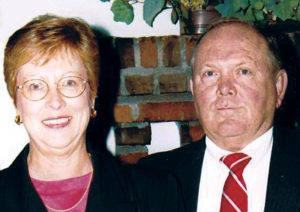Former head of the EPA’s National Risk Management Research Laboratory (NRMRL)
An unsung hero of the geoenvironmental and geosynthetics fields is a retired former research director at the U. S. Environmental Protection Agency (EPA), Mr. Robert E. Landreth. It was Bob Landreth’s vision and tenacity in advocating for research funds that made possible pioneering research in the 1980s that led to dramatic increases in use of compacted clay and geosynthetics for waste containment applications and to better engineering of waste containment liner and cover systems.
The pioneering advances made possible by this research literally changed the way that waste materials were managed, not only in the U.S. but throughout the world. It was the researchers, including students, professors, and professionals in industry, who performed the research, but it was the advice and guidance from Bob that was critical in conceiving, funding, and communicating that made all these outcomes possible. He is truly a giant of the geoenvironmental and geosynthetics industries.
Bob graduated from New Mexico State University with both bachelor’s and master’s degrees in 1963. He joined the U.S. Public Health Service and was later detailed to the EPA. His first assignment was in Cincinnati, Ohio, training state public health officials in radiological health issues.
In 1966, he was transferred to Las Vegas where he was a member of the aerial group monitoring the Nevada Nuclear Test Site. In 1972, Bob was transferred back to Cincinnati, where he spent his career until retirement. He was critical in developing the research database in support of the federal regulations on the use of natural soils and geosynthetics in both hazardous and non-hazardous waste management.

These regulations were embodied in the 1982 Resource Conservation and Recovery Act (RCRA) legislation for hazardous solid waste (HSW) as Subtitle “C” and for municipal solid waste (MSW) as Subtitle “D.” They were subsequently extended to heap leach mining, coal combustion residuals, and surface impoundments for all types of solid and liquid disposal.
It was at the EPA’s National Risk Management Research Laboratory (NRMRL) where he was pivotal in implementing engineered landfill and surface impoundment lining systems, as well as landfill cover systems for EPA and Superfund sites. This entailed all types of natural soil and geosynthetic materials.
In addition to performing in-house research at his Cincinnati EPA laboratory, Bob funded many individual research projects at universities, consultancies, and other governmental laboratories. Topics varied among a balance of manufacturing, design, testing, installation, contracting, quality control, and quality assurance. This plethora of information was daylighted by conferences, symposia, and workshops, many of which were held at the EPA in Cincinnati.
At the time, throughout the 1980s, these EPA conferences were must-attend meetings for anyone in the industry who was interested in changes in waste disposal technology. The state of the art was literally redefined every year at these meetings.
To transfer this knowledge base directly to state environmental regulators, Bob formed a team of speakers in 1988 for landfill liner training courses, conducted in each of the 10 EPA regions. These courses were free and open to EPA staff, state regulators, engineers, owners, etc.
The course format was quickly established. Bob presented the regulations, Dave Daniel focused on compacted clay liners (CCLs) and other natural soils, Bob Koerner presented geosynthetics, and Greg Richardson presented an array of topics that captivated everyone in attendance.
Two years later, a second course series was held, which focused on landfill closures. Paul Schroeder joined the team to describe the EPA’s Hydraulic Evaluation of Landfill Performance (HELP) model. Approximately 10,000 regulators attended these 20 regional EPA courses, and for most this was their first exposure to modern landfill design practices and procedures. Even decades later, it is not rare to meet with regulators regarding a landfill or surface impoundment to discover that someone in their group had attended one of these courses.
Over the years, Bob’s sponsored research with various contractors resulted in the following benchworks:
- Compacted clay liners (CCLs) having hydraulic conductivity: ≤ 1 × 10–⁷ cm/s.
- CCL thickness of 600mm for MSW and 900mm-thick for HSW.
- Geomembranes—called flexible membrane liners (FML) in regulations—of at least 0.75mm, or 1.5mm for high-density polyethylene (HDPE) thickness.
- Geomembrane resin type was site-specific.
- Composite GM/CCL or, later, GM/geosynthetic clay liner (GCL) action.
- Intimate contact required between geomembrane and underlying clay.
- Double-lined systems with leak detection required for HSW.
- Maximum leachate head on geomembranes of 300mm.
- Gravity flow drainage (minimum of 2% slope) for leachate collection and leak detection.
- Minimum time for leachate to reach downgradient sump of 24 hours.
- Incorporation of GCLs and geonets on site-specific basis.
- Significant latitude for individual states, via their solid waste director, provided that technical equivalency to the federal regulations could be shown.
Whatever was the former site-specific situation (most generally, dumps) before Bob, waste disposal is currently a major activity for professionals in the U.S. and around the world and is immeasurably more environmentally safe and secure in comparison to the past.
The tremendous insight, perspective, guidance, determination, and support shown by Bob Landreth is a testimony to the very best of regulators and regulatory agencies. He played an absolutely critical role in changing the world for the better. Everyone in the waste containment industry owes him a sincere depth of gratitude.
Bob retired in 1996 and enjoys woodworking activities and his garden challenges. He and his wife, Mitch, live in Cincinnati; they have two daughters and three grandchildren. We wish him and his family well.
 TEXTILES.ORG
TEXTILES.ORG


